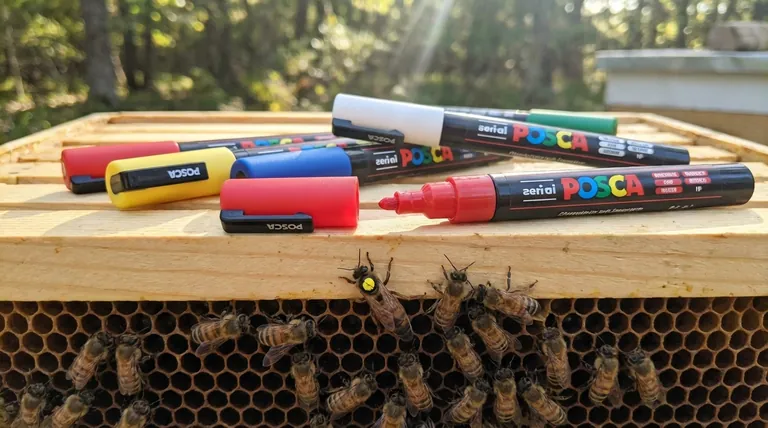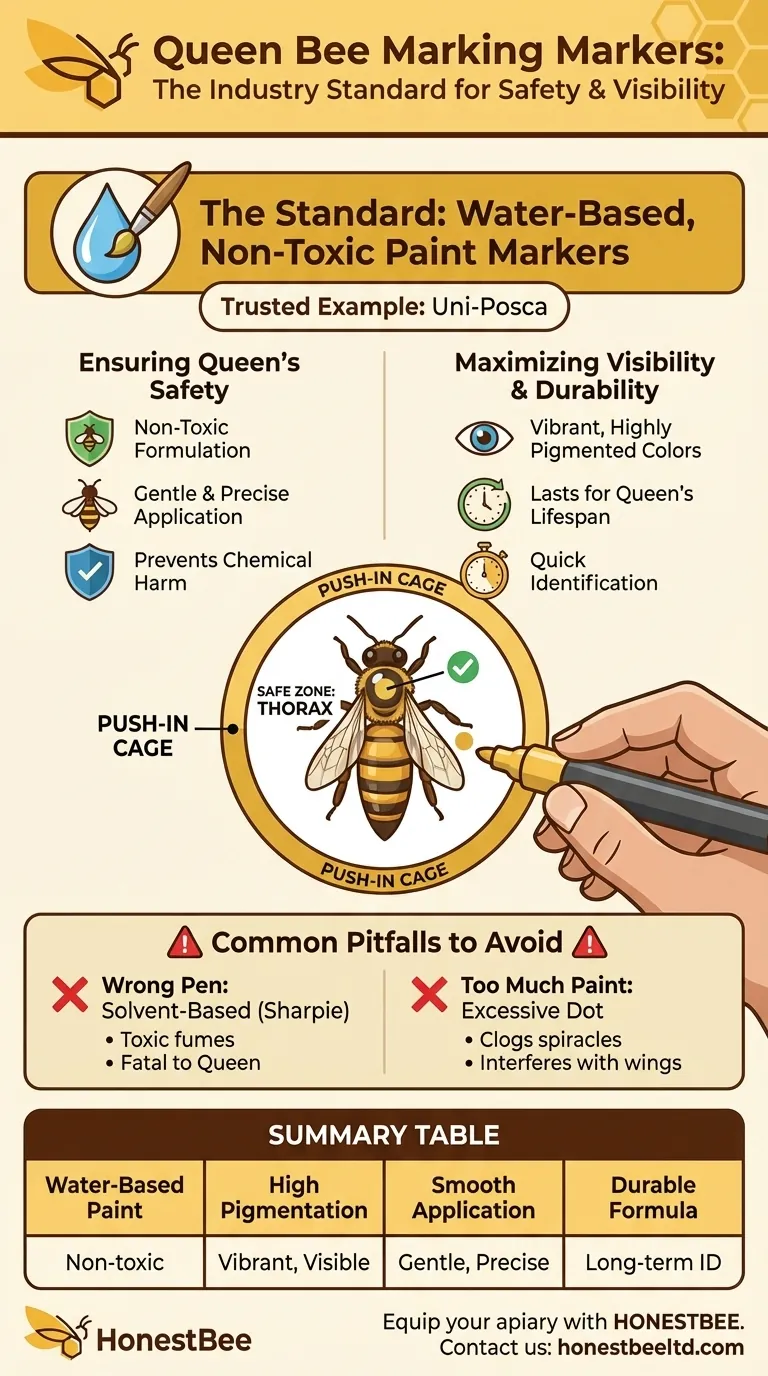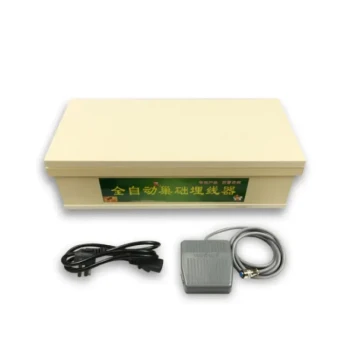The standard for marking queen bees is a specific type of water-based paint marker. The most widely used and trusted brand for this task is the Uni-Posca marker. These pens are favored by beekeepers because their water-based acrylic paint is non-toxic, highly pigmented for visibility, and applies smoothly with minimal pressure, ensuring the queen's safety.
The critical factor is not the specific brand, but the marker's properties: it must be a water-based, non-toxic paint pen with vibrant pigment. This ensures the queen's safety while maximizing her visibility for effective hive management.

Why These Markers are the Beekeeping Standard
The choice of a marking pen is centered on two non-negotiable principles: the health of the queen and the efficiency of the beekeeper. The right tool achieves both.
Ensuring the Queen's Safety
A queen bee's health is paramount to the colony's survival. Any substance applied to her must be completely harmless.
Uni-Posca markers use a water-based acrylic paint that is low in toxicity. This prevents any chemical harm to the bee when the dot is applied.
The pen's design allows for a gentle and precise application. A small, clean dot can be placed on the queen's thorax without excessive pressure that could injure her.
Maximizing Visibility and Durability
The primary goal of marking a queen is to be able to find her quickly among tens of thousands of other bees.
These markers are known for their vibrant, highly pigmented colors. This makes the marked queen stand out clearly against the darker background of a crowded frame.
The acrylic paint is also quite durable once dry. A single, properly applied mark can last for the queen's entire lifespan, which can be several years.
The Practicalities of Marking a Queen
Beyond selecting the right pen, the technique and tools used during the marking process are crucial for success and safety.
Using the Correct Tools
For many beekeepers, especially beginners, a round push-in queen marking cage is an essential tool. This device gently holds the queen in place on the comb.
This immobilization allows for a steady hand and a more accurate application of the paint, reducing stress for both the beekeeper and the queen.
Applying the Mark Correctly
The only safe place to mark a queen is on the top of her thorax. This is the hard-shelled middle section of her body, between her head and abdomen.
Marking any other part, such as her abdomen, wings, or antennae, can interfere with her movement, flight, or ability to lay eggs. A single, small dot is all that is required.
Common Pitfalls to Avoid
While the process is straightforward, simple mistakes can lead to negative outcomes. Being aware of them is key to a successful marking.
Using the Wrong Type of Pen
Never use a solvent-based marker, such as a Sharpie or other permanent ink pen. The chemical fumes and components are toxic to bees and can be fatal to the queen.
Stick exclusively to water-based, non-toxic paint pens that are proven to be safe for this specific purpose.
Applying Too Much Paint
A common mistake is applying too large of a dot. This can clog the queen's spiracles (breathing pores) or drip onto her wings and joints.
The goal is a small, neat dot that is just large enough to be seen easily. Prime the pen on a separate surface first to ensure smooth, controlled paint flow.
Making the Right Choice for Your Goal
Selecting and using your marking pen correctly will make your hive inspections faster and more effective.
- If your primary focus is safety and reliability: Always choose a water-based, non-toxic paint pen like a Uni-Posca, which is trusted and recommended by beekeeping suppliers.
- If you are new to marking queens: Invest in a marking cage to immobilize the queen gently, allowing for a more precise and less stressful application for everyone involved.
- If your goal is long-term identification: Apply one clear, vibrant dot to the center of the thorax and ensure it is fully dry before carefully releasing the queen back into the hive.
By prioritizing the right materials and a careful technique, you can safely mark your queen and streamline your beekeeping efforts for years to come.
Summary Table:
| Feature | Importance for Queen Marking |
|---|---|
| Water-Based Paint | Non-toxic and safe for the queen's health, unlike solvent-based inks. |
| High Pigmentation | Creates a vibrant, visible dot to easily spot the queen in the hive. |
| Smooth Application | Allows for a gentle, precise dot on the thorax without harming the queen. |
| Durable Acrylic Formula | The mark lasts for the queen's entire lifespan, providing long-term identification. |
Equip your apiary with the right tools for success. HONESTBEE supplies professional beekeepers and equipment distributors with the highest-quality, trusted supplies—including safe marking pens and essential hive management tools. Ensure the health of your queens and the efficiency of your operations. Contact our wholesale team today to discuss your needs.
Visual Guide

Related Products
- Queen Bee Marking Pen POSCA Queen Marking Pens for Beekeeping Bee Markers
- Queen Bee Marking Pen UNI Medium Point for Queen and Bee Marking
- Professional Engraved Round Hive Number Tags for Beekeeping
- Wooden Bee Brush with Triple Row Artificial Fiber for Beekeeping
- Wooden Bee Brush with Double-Row Horsehair Bristles
People Also Ask
- What are the benefits of learning to mark your own queen bees? Boost Your Apiary's Efficiency and Confidence
- What are the Queen marking colors associated with specific years? Master Hive Management with the 5-Year Color Code
- What is the purpose of marking queen bees with colors? Essential for Hive Management & Efficiency
- What are the advantages of marking a queen bee? Achieve Precision and Confidence in Hive Management
- What should you do immediately after marking a bee? Ensure a Clean, Durable Mark with This Key Step



















